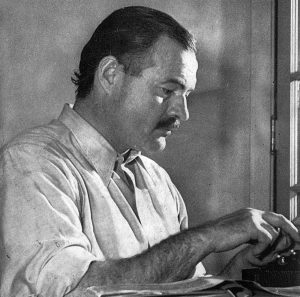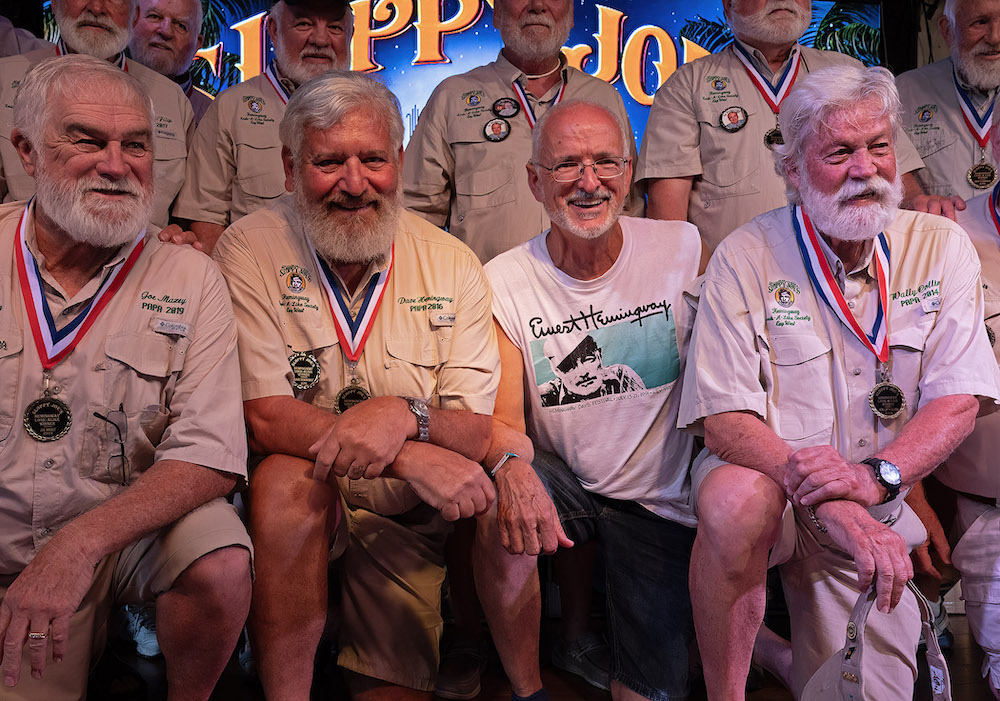Key West’s Hemingway Days — set this year for July 16-21 — is an internationally recognized celebration saluting the legendary author who lived and wrote on the island for almost a decade. Its Look-Alike Contest draws about 150 entrants each year, and the associated Look-Alike Society has awarded nearly $350,000 in scholarships to local students.

Michael was a manager at Sloppy Joe’s when he conceived the idea for the festival more than 40 years ago. (Photo by Andy Newman, Florida Keys News Bureau)
But when Michael Whalton conceived the festival more than 40 years ago, he couldn’t possibly foresee what it would become.
At the time, he was a day manager at Sloppy Joe’s Bar, renowned as a hangout of Ernest Hemingway’s when he lived in 1930s Key West.
Michael directed the festival for 16 years before moving to West Virginia in the mid-1990s. Under his leadership, Hemingway Days grew from a local event into a widely acclaimed tribute to Ernest’s literary mastery, vigorous lifestyle and enduring affection for Key West and its people — including Sloppy Joe’s owner Joe “Josie” Russell.
Last July, Michael attended Hemingway Days for the first time since his departure — and reflected on the iconic festival’s beginnings, growth and ongoing popularity.
Keys Voices: How did you get the idea for Hemingway Days?
Michael Whalton: In December of 1980, I read an article about the Bad Hemingway Contest held in Los Angeles. It was a writing competition to parody Hemingway’s writing. And because Sloppy Joe’s had such a history with Hemingway and Josie Russell, it seemed like we could do something to honor Hemingway here in Key West.
Hemingway’s birthday was July 21, and I thought we might create a festival around that. I figured it would be a good way to bring business in — summer was a slow time back in 1981. We thought we would do a short story competition, a Look-Alike Contest and a street fair. And then we decided to do a beer-drinking contest as well.

Ernest Hemingway lived in Key West for most of the 1930s. In this photo taken in 1953, he writes at his safari camp desk in Africa. (Photo courtesy of the Ernest Hemingway Photographs Collection; John F. Kennedy Presidential Library and Museum, Boston)
KV: How did the Hemingway family get involved?
MW: About a month before the festival, one of the bartenders told me a guy who said he was Ernest Hemingway’s brother wanted to talk to me. Leicester Hemingway, Ernest’s 18-years-younger brother, had just finished doing a billfish tournament in Key West and he wondered if he could enter the Look-Alike Contest.
KV: What could you possibly say to that?
MW: I said, “Mr. Hemingway, I’m sorry. Why don’t you be the judge for the Look-Alike Contest?” So Les became the judge of the first Hemingway Look-Alike Contest. Through him, I met his wife, Doris, and their daughters. I also met Lorian Hemingway and she agreed to be the judge of the short story contest.
KV: Was the first Look-Alike Contest successful?
MW: The week before the festival, we had nobody sign up for the Look-Alike Contest — so I called everybody I knew in Key West who had a beard and begged them to come down to the bar. They all showed up, and about 20 other gentlemen who had beards came in.
We ended up with, I think, 36 contestants the first year. The winner was Tom Feeney, an officer in the Coast Guard. When we chose Tom as the winner, Les Hemingway said, “There’s no second place. Everybody gets to think that they were the runner-up.”

Michael happily returned to the stage at Sloppy Joe’s during the 2023 festival’s look-alike events. (Photo by Andy Newman, Florida Keys News Bureau)
KV: How did the other events go?
MW: The beer-drinking contest was less successful. The fellow who won actually ended up being discovered the next morning naked in a neighbor’s yard, so we canceled that event. But over the next few years, we added several new events, including a party at the Hemingway Home & Museum and the billfish tournament.
KV: Did you have prizes for the early Look-Alike Contest?
MW: When the look-alikes won, they became judges for the next year. But in those early years, we didn’t have a lot of exciting prizes for them. We had a case of Fundador Brandy and a front-end alignment from Boa’s Tire and Auto, which always got a laugh from the audience.
KV: What do you think Hemingway means or meant to Key West?
MW: When Hemingway lived in Key West throughout the 1930s, he was a prominent figure on the island despite trying to keep a low profile. And he attracted many other writers who became instrumental in the success of the arts community here.
KV: When you started Hemingway Days in 1981, did you ever imagine it would still be flourishing?
MW: It’s pretty amazing how much it’s grown and how successful it’s become. The look-alikes do a great job of bringing enthusiasm and excitement into the island, and the fact that they raise so much money for scholarships every year is delightful. More than 40 years later, this festival is bigger and better than ever.

